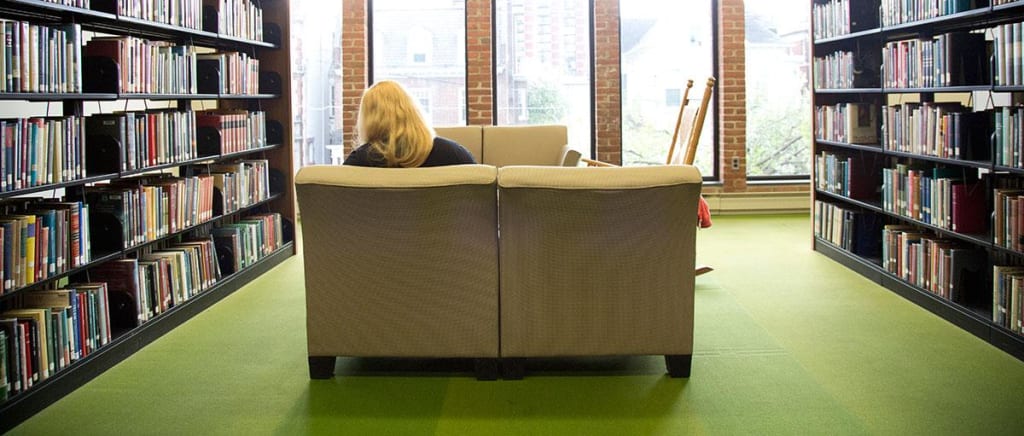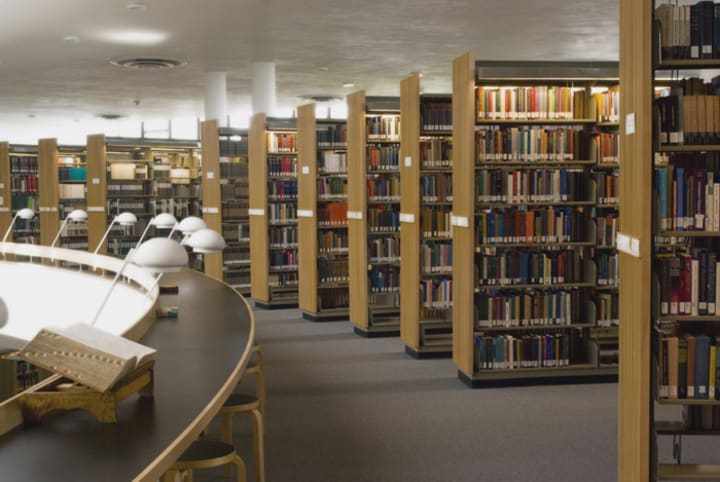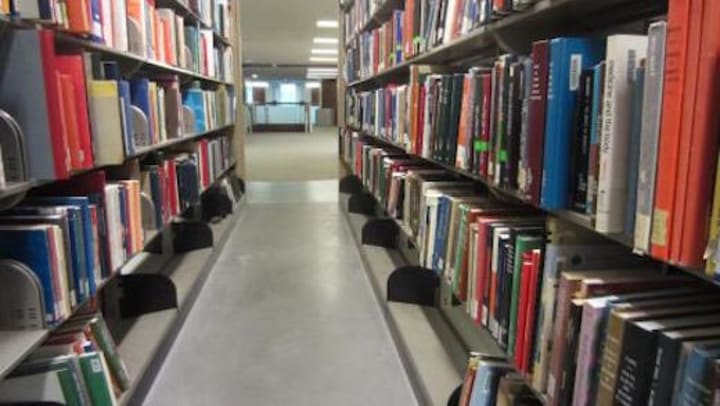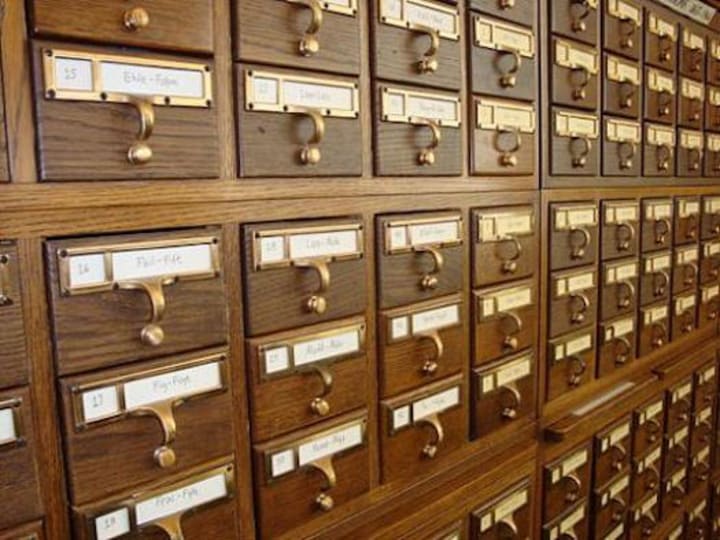The Library Is Changing at the Speed of Google
The ways of research and reading are fast-changing. Here's how campus libraries can successfully adapt and remain central to learning in today's environment.

The university library. For those of us of a certain age, many, many an hour was spent there. When we walked uphill through the snow - bothways, of course - to do research, there was simply no alternative. The university library was the place to be. It was where all research started. When you needed to do research, the library - not the World Wide Web - was your source of all information. Yes, it was also a social place and a study space, but more than anything else, the purpose of the library was clear: It had "the stuff" you needed to research anything - and there really was no alternative!
Back in the day - and in historical terms, it really wasn't all that long ago, all of human knowledge was not available with a couple of clicks on that powerful device in your hand. In order to access the slice of human knowledge available to you at any moment was dependent on just how big and how voluminous the library at your particular institution of higher learning happened to be.
In fact historically, universities competed - in a very male mindset I must admit - as to whose library could be the biggest! The size - in terms of the sheer number of "holdings" - defined as "the materials owned by a library" - has historically been a point of prestige for colleges and universities. Back in the days before colleges competed based on the size of their rock-climbing walls and their lazy rivers (you have to have both these days, right?), the size of the library's holdings was one of the main criteria on which institutions competed. Library holdings were a main selling point for colleges, and even yes a recruiting tool for students and for faculty! Universities spent big bucks to add to their collections, yes to facilitate research, but also to be able to simply say that "my library is bigger than your library!" And yes, those rankings still exist and are still produced by the the American Library Association (ALA).
However, size did matter in this instance, as the more resources - books, journals, monographs, magazines, films, etc. - that were available at your university, the easier that it was for you to actually conduct research. This held true for all, whether your were a faculty member working on a book, a doctoral student trying to write his or her dissertation, or a desperate undergraduate student pulling an "all-nighter" to try and do that semester-long research paper in one long day (and night!).
And so for students, up until the real advent of the Web, the library - and the "stuff" there - was absolutely necessary to get "stuff" done. And yes, all the paper, all the microfiche (Google it kids...), and all the dreaded microfilm (Google that one, too!) mattered a great deal, because the more "stuff" your local library had, the easier it was to get things done (yes, there was interlibrary loan where libraries - get this - actually mailed articles, books, etc, to each other that you needed for your research)!

Look at the size of that dictionary, kids!
And so in the typical university library - well, every university library until recently, the one constant between all of them was "the stacks." The stacks went on row after row, aisle after aisle, and quite often, floor after floor. The stacks were composed of metal or wooden shelving that housed all this knowledge - in one physical form or another - books, journals, periodicals, etc. The shelving was typically tall and long in size, affording one privacy, but also making one feel like a mouse in a maze at times.
Many of us have fond memories of spending time in those stacks. Yes, many will recount hours and hours spent doing research there! And yes, literally God only knows what else happened in those secluded and isolated - and sometimes even scary spots! Ah, the stories your parents, your grandparents... your great grandparents might tell about making out, drinking beer, smoking "stuff" in the library stacks, etc., if you just get them started!

Of course, the main reason for spending time in the stacks was simple: That was where the "stuff" was that you needed to research your topic. But with seemingly endless rows of look-alike shelving and literally tens, perhaps hundreds of thousands of separate articles, you had to know how to navigate the stacks to find the precise items that you needed for your particular project. And no, there was not an app for that, back in the day! There was really only one way to navigate the stacks, and that made the card catalog the student's "best friend."

Now, about once a week I see a meme similar to the one below that a friend has posted to Facebook, lamenting how we "people of a certain age" searched for information the old fashioned way - using the card catalog. Now searching the card catalog was very labor intensive. It was inefficient. It was not precise. And yes, at the end of the process, there was always that sinking feeling of wondering if the book or journal that you were looking for would really be on the shelf - and in the right place to be able to find it! If something got put in the wrong place - either through a mistake or due to a highly competitive student hiding that "perfect" resource so that no one else in the class could use it (and that did happen, kids!), well, it might as well be in another country!

Say what you will about the "good old days," but being able to access almost anything published anywhere instantaneously on the Web or in library databases is a true quantum leap in terms of how we can conduct research! Yes, card catalogs make interesting antiques today, but the computer and the smartphone do make things far, far easier today!
The library is fast-changing. And to both survive and to remain relevant for today's students, both the stacks and the card catalogs are fast disappearing - along with most, if not all, of the printed materials - books and all! What is rising in the place of all those dust-gathering books and furniture is an exciting new model of learning, well-suited for a new digital, collaborative age. And the fascinating thing is that all across the country - and indeed around the world - the adaptation of the modern library to a digital, connected future is speeding along rapidly - and organically!
Dan Cohen recently wrote a fascinating piece on the state of the university library for The Atlantic. Entitled "The Books of College Libraries Are Turning Into Wallpaper," the article is especially insightful precisely because of who wrote it. If the name Dan Cohen doesn't stand out to you, well just like David Wyld (hey, I'm trying to change that...), it likely shouldn't. However, this Dan Cohen just happens to be one of those important people in academic circles - and yes, he currently has three titles to prove it. Presently, he serves as Vice Provost for Information Collaboration, Professor of History, and oh by the way, Dean of the Library at Northeastern University in Boston. Now that's some academic "street cred" right there for Dr. Cohen...
The point of Dr. Cohen's article is a very interesting one. This is the fact that what he labels as a "Great Sorting" is taking place in terms of the functions, the look, and indeed the services that university libraries will offer, both today and into the future. To me, as a strategic management consultant and professor, this is a fascinating conundrum, as today, both libraries and librarians are being challenged to change in fundamental ways. And at institution after institution, libraries are largely thriving in this adaptation process. Today, the campus library is fast becoming even more central to the student learning experience, even as, yes, the books are less and less a part of the library experience.
How much has the research and reading game changed? In his article, Dr. Cohen cites study after study that basically says that if you thought the shift to e-books and Google has made a difference, well, you are probably tremendously underestimating just how much the shift to digital resources and online research has impacted libraries. At his own library at Northeastern University, the number of books checked-out by undergraduates declined by half in just five years - between 2013 to 2017! Take the University of Virginia, unquestionably one of the nation's foremost research universities, as a case study as Cohen did. At UVA, a decade ago, students checked out 238,000 books. In the last academic year, UVA students only checked out approximately 60,000 books. Across all of is libraries in its system, the University of Virginia circulated well-over half a million books during the 2007–08 academic year. A decade later in the 2017-18 academic year, that number had fell to only under 200,000! This means that in real terms, as Cohen pointed out, "nearly 1,000 fewer books checked out a day." Cohen also cited research from the Association of Research Libraries’ that shows that across the country and across all levels and sizes and any other categorization you could make about colleges and universities, the statistics show just how fast - and how far - the circulation of printed materials of all kinds has fallen.
Such circulation statistics on books just do not justify keeping the status quo for university libraries. And while some may counter these statistics with the argument that students and faculty doing research still "touch" books by consulting them in the library, the actual usage statistics show otherwise. Simply put, with the advent of digital, there are less and less reasons to have to go to the physical library to consult with a physical, printed resource. And with libraries allowing for remote access into databases that make researching through a whole range of resources - not just e-books, but academic journals, periodicals, newspapers, government documents, dissertations, etc. - one no longer has to go to the library to use the library!
Indeed, the world has changed - and despite the calls of "Luddites" that believe the campus library should be lined with books and not allow conversations or coffee - there simply is not turning back the sweeping tide of technology that is changing the library - and largely for the much, much better!

The truth is that these physical resources are getting dusty(ier) and simply not moving off the shelves. In response, many university libraries are removing most - if not all - of their physical copies of books, storing them off-site and having them available for retrieval on demand. Now, there are typically disgruntled faculty and alumni at campuses where the "great migration" of books to the warehouse - or to the shredder - has happened, but despite some "read-ins" and faculty senate actions, nothing has really stopped the march of digital progress. From Yale to Syracuse to Indiana University of Pennsylvania and on an on and on, universities are sifting and sorting through their collections, and shifting more and more of their holdings to storage facilities - or yes, to buyers, to recyclers, and yes, even to the dumpster or shredder. The economics certainly play a role in all of this, as it costs universities, on average, $4 a year to host and circulate a physical copy of a book on the shelves of their library. And architectural constraints certainly play a role as well, as many libraries simply have run out of physical room to store all of their holdings in one central location - let alone on the campus even if in warehouses.
What I find fascinating about all of this is that library leaders across the country are coming to the same conclusion - the game is not just changing for libraries, it has changed - and changed radically! And so while they may go to different conferences, read different journal articles, and consult different articles in library trade publications, librarians have come to basically the same conclusion. And their individual reasoning that has produced overall, a collective consensus, can be summarized in four words: We have to change! And you can add a word of urgency to that - in that at libraries across the country, library and university leaders are - by and large - acknowledging that not only do we have to change, but we have to change fast!
More and more, library leaders are correctly seeing themselves as not being in the book business. Rather, they are in the learning business. And to be even more specific, they are really, really in the information business! Cheryl Middleton is a Past President of the Association of College and Research Libraries and an Associate Librarian for Research and Scholarly Communication at Oregon State University. She observed recently that the university library could no longer be seen as "just a warehouse" of information. Rather, the library is taking on a role where it is "kind of like the living room of the campus."
And that is important, as increasingly, the library - which is generally a central point on campus and prime real estate - is actually being utilized more and more by students as the library itself both responds to their changing learning and information needs and creates new opportunities for student learning and interaction to occur. When you don't need the room to be a warehouse of printed materials without the need for all those stacks and stacks and more stacks..., that frees up the library to be a place where students can gather - safely (a factor not to be taken for granted today!).
Campus libraries today are becoming not just digital hubs, with many school-owned computers, printers, scanners, and more for students to use and with wifi inviting them to BYOD (bring your own devices), but meeting places for the more collaborative studying, group work, and team projects that are in vogue to better prepare college students for the increasingly cooperative and connected work world they will be entering. Libraries are facilitating that "living room" feeling with not just the comfy couches that one might have taken a nap on in the past, but study spaces and group rooms, with some even adding special tech-enabled rooms for them to make videos and/or practice presentations.
And yes, both to facilitate students spending more time in the library and yes, universities being - ahmmmmmmm - non-profits (but that doesn't stop them or their food service providers from trying to sell more product and make more money!), libraries often become like a very large Starbucks! Some libraries now even have multiple food and beverage offerings, either spread out in the facility for convenience or concentrated to almost form - gulp - a food court!
And now, libraries totallywithout books are indeed happening. While still a rarity - and there have been a few community libraries that have went totally paperless (including the Bexar County BiblioTech Library in San Antonio, Texas), this idea has taken flight in higher education.
Of course, it is easier to start with a blank sheet of paper! In fact, Florida Polytechnic University - a university that just opened in 2012, chose to become the first university in the country to have a library without books! Starting from scratch, the university created a beautiful building in which the library, designed by Spanish architect Santiago Calatrava and costing some $60 million dollars to build....

... with a unique, expansion mission and vision for the library to become much more than just "the library." Rather, they envisioned that their library, called the Commons, "will be a central hub of student success by providing a variety of information-based services." Still, the library has a collection of 135,000 digital holdings, and in a system driven by actual usage, additional e-books will be added on their second usage by a Florida Poly student or faculty member.

Florida Polytechnic University Library Vision Statement, Source: https://floridapoly.edu/about/divisions-and-departments/technology/digital-library/
The founding director of the university's digital-only library and now the university's Vice Provost for Academic Support Services, Dr. Kathryn Miller, told the Library Journal that with the Commons: “We want our students to recognize when they have an information need and be able to locate the relevant information to apply it in a scholarly and, ultimately, professional way.”
Yes, if you have not been to a library on a college campus lately, you are likely to be in for quite a shock! From a strategic standpoint - and to their credit, libraries - and librarians - are really seeming to both respond well to the changing needs of their customers (i.e., the students) and anticipate how to innovate to become even more of an important place - and space - to serve their student populations. While it would be great to not have to deal with the analog past and start just with the digital future - ala Florida Polytechnic, 99.8% of all colleges and universities around the world will be challenged to adapt their libraries to the times. And yes, to date, the results have been impressive!
As one who did spend many hours in the stacks "back in the day," I am encouraged - tremendously encouraged - to see the progress made to date by universities - spearheaded by visionary leaders - and by their librarians - to adapt to the times. University administrators are generally cautious by nature and have to deal with faculty who are even more cautious - and stubborn - in their ways (trust me on this based on almost three decades of inside knowledge!). So to allow for, to make, to create, and yes - to lead and inspire - such radical change within the institution is a radical act in the world of academia!
I will be excited to see how - in a matter of five, ten, twenty more years, the campus library evolves even further, getting away from the stacks of the past to become a hub of student life - and innovation - into the future. I believe that the changes we have seen to date may even pale in comparison to what will be the library of the future - and perhaps the very near future!
At the same time, I have to say before I close that I do relate to some of the Luddites and curmudgeons that I have run across in researching (yes, of course, in 2019, from my computer) this topic. As Kathleen McCook, a Professor of Librarianship at the University of South Florida lamented the loss of "that very quiet and intimate connection between people and the printed word" as books - as we have known them - begin to be shipped out of libraries to make way for more study spaces, maker labs, and yes, coffee stands. She went on to say that without physical books, a library "just (is) not going to give people the serendipitous experience of walking though shelves of books – a tremendous rite of passage." While that time is indeed passing, the digital library offers a world to students really without limits - and that - that - is a very good thing!
And at the same time, I am impressed that there are so many different efforts underway - within and even between state university systems and across both public and private colleges - to ensure access to printed books for years to come. There are various initiatives underway to create what might be termed "metacollections" of books across institutions, both in the digital space and still, physically. And while the digital world is fast evolving, the idea to preserve books - and to preserve the ability to access copies of physical books - is still seen as vitally important.
David Prosser, Executive Director of Research Libraries UK (itself a consortium of leading university libraries in the United Kingdom and Ireland), has recently urged that libraries should band together and begin "looking at collections collectively." With such “collective collections,” Prosser argues that:
“Print books are historical artifacts … but some are more valuable artifacts than others. No library can be completely universal and decisions need to be made about what to collect and where to store material. By looking at collections collectively we can better serve the needs of readers, ensuring that what we have is well looked after (and yes, sometimes that means in ‘remote-storage’).”
Gone are the days, as Prosser says, that the library was judged by its collections. Now, it should be judged based on its ability to serve its customers' information and learning needs - and sometimes, yes, that will mean the provision of physical books. But in a world on one-day shipping, it really, fundamentally will not matter to future students and scholars whether the book comes in a package from around the corner or literally, from around the world - so long as they have access to it. And in time, access to the physical copy of the book may be less and less needed as successive generations of researchers come to rely on digitized print rather than actual print - and that is fast changing!
Think about how Prosser framed his argument in his article, which was actually a response to a piece entitled "Destroying the Gutenberg Galaxy of Books Will Leave a Black Hole." This hyperbole-titled piece was written by two liberal arts professors (Al Martinich and Tom Palaima) lamenting the loss of physical books at their institution, The University of Texas at Austin. Prosser responded in what we in academia like to call a "classic takedown" that:
"The argument is that of an accountant. The undergraduate library at UT Austin once housed 157,000 books. Now after a refurbishment, 90,000 were moved elsewhere and computers and a café were added. That, Martinich and Palaima argue, is clearly a bad thing. This accountants’ argument – removing 90,000 from 157,000 leaves a smaller number and smaller numbers are bad – reminds me of slides I used to see in library talks 10 to 15 years ago. Any librarian would have as their second slide (after the title slide) the most striking picture of their library estate and a list of statistics: budget, number of volumes, kilometres of shelving, etc. More was good, bigger was best. There was not a hint about level of service, or how the library met the needs of readers. Just a boast about the amount of stuff they had."

And so yes, the campus library is fast changing! And what is truly exciting is that today, students are spending ever more time using the library and at the library. In the end, I think that all of this does improve learning - and yes, I do believe that the metrics will show that student outcomes - i..e. the dreaded "student success measures" - will improve as the library changes at the speed of Google!

About David Wyld
David Wyld ([email protected]) is a Professor of Strategic Management at Southeastern Louisiana University in Hammond, Louisiana. He is a management consultant, researcher/writer, publisher, executive educator, and experienced expert witness. He is the founder and publisher of both The IDEA Publishing (The Best in News, Information and Content Marketing) and Modern Business Press (Creating the Readable - and Enjoyable - Academic Journal - Not an Oxymoron!).
David Wyld’s Online CV
Social Media Links to David Wyld:
on Facebook
on Twitter
on LinkedIn

Professor David C. Wyld
A Simple Way to Show Your Support for Professor Wyld and the Vocal Platform
Like what you just read? Did it make a difference to you? If so, please see and share this article through social media, email, and even the old-fashioned way of printing it off for a colleague or friend!
And while you’re at it, ask yourself a simple question: Was the info worth a buck or two—or perhaps a whole lot more to you, your career, your company? If so, please consider “tipping” (after all, it is the polite thing to do!) using the easy link below. In providing a small tip—even a dollar or two, you not only help support the author's work, but you help keep the unique platform that Vocal Media is building be an advertising-free environment—and don't we all need more of that to make our online experiences better today? Please consider showing your support below and voting for good writing and ad-free content on the web by hitting "Send Tip!"
About the Creator
David Wyld
Professor, Consultant, Doer. Founder/Publisher of The IDEA Publishing (http://www.theideapublishing.com/) & Modern Business Press (http://www.modernbusinesspress.com)






Comments
There are no comments for this story
Be the first to respond and start the conversation.